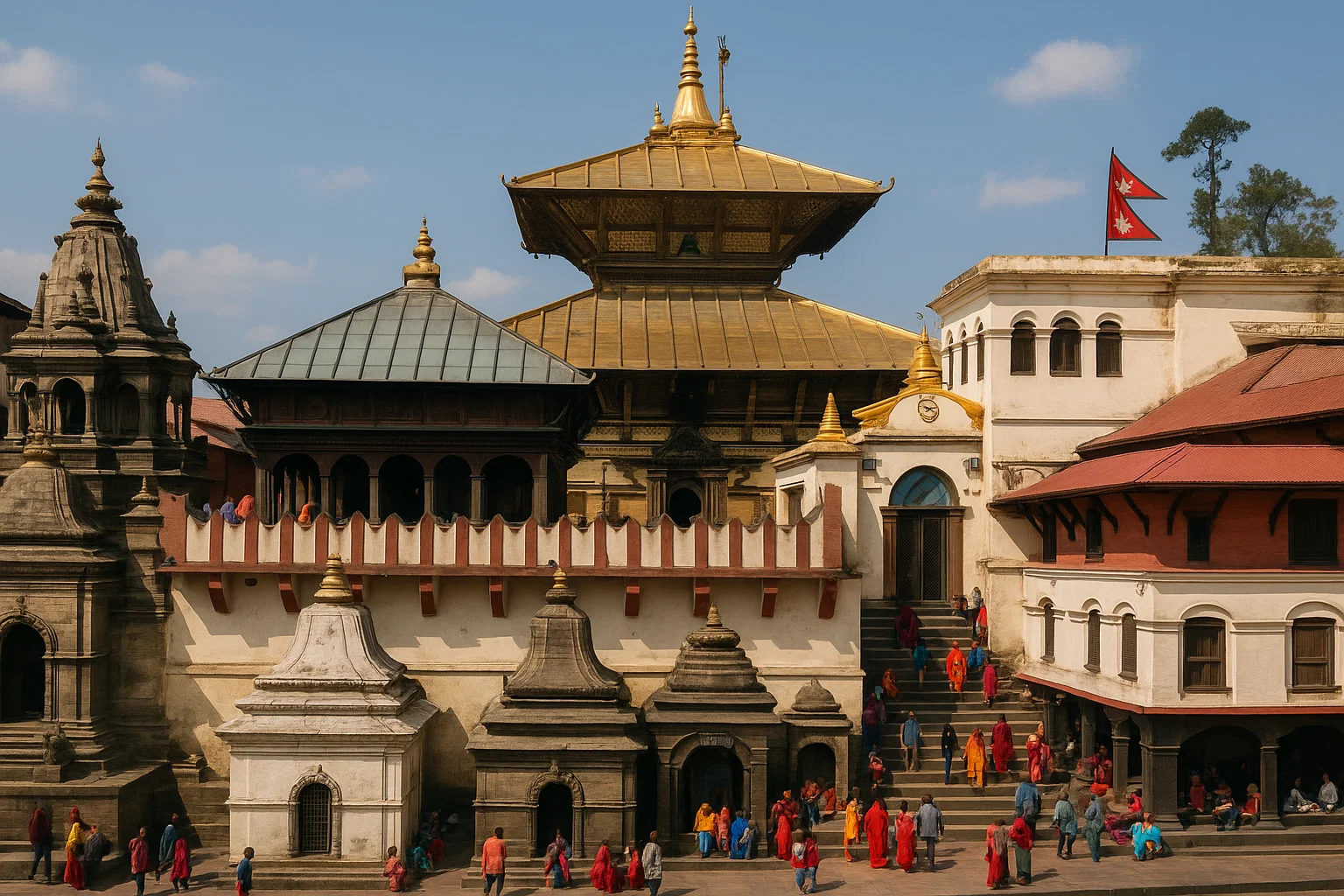The Shree Pashupatinath Temple Kathmandu sits right on the edges of the sacred Bagmati River in Kathmandu. Nepal counts this spot as a key destination for Hindu pilgrims worldwide. Countless visitors from everywhere head to this old temple setup, dedicated to Lord Shiva as Pashupati (the protector of creatures). It serves as the core spiritual hub for Nepal.
A Temple with a Long History
The Pashupatinath Nepal Hindu Temple has stood as a worship site for over 1,500 years. Its true beginnings remain unclear. Findings from digs show the area held holy status from at least the 5th century CE, making it among the oldest Hindu temples still active today. The existing structure, though, has gone through multiple updates and rebuilds across time.
Hindus hold that the pasupati temple nepal came about when Lord Shiva shifted into a deer form and roamed the woods of the Kathmandu Valley. Once the other deities spotted him, he leaped across the Bagmati River, snapping his antler along the way. The lingam honored at the temple today marks the exact location where that antler landed.
The Himalayas’ Architectural Wonder
The pashupatinath temple nepal kathmandu features stunning Nepalese pagoda design that has shaped temple construction across the area. The primary temple includes a distinctive double-level gold roof with intricate engravings and skilled work. It rests on a square foundation and includes four main entrances. Each entrance gets guarded by silver-covered images of various deities.
The temple’s gold pinnacle catches attention above all. It gleams sharply against the Himalayan base. The setup holds multiple smaller sanctuaries, retreats, and yards that form a winding holy space where visitors locate peaceful areas for reflection and devotion.
The pashupati temple in Kathmandu, Nepal, got constructed without any iron involved, following ancient Hindu building practices. The elaborate wood carvings display mythical beings, blooms, and faith symbols that convey tales from Hindu scriptures and regional stories.
Religious Practices and Spiritual Importance
This holy location holds massive value for Hindus globally as the top pashupatinath temple in Nepal. Folks in Nepal view Lord Pashupati as their shielding deity, and the temple as the nation’s faith guardian. Nepal’s royal line used to visit here for approvals before major occasions and choices.
Only Hindus get entry to the main inner chamber of the temple, sticking to strict faith guidelines. Visitors from any background can watch the routine ceremonies and events from the Bagmati River’s east bank, however. The dawn and dusk aarti (worship sessions) create an enchanting atmosphere with bell rings, chants, and classic tunes.
The temple acts as the center for one of Nepal’s largest faith gatherings during Maha Shivaratri. Hundreds of thousands of devotees from India and Nepal arrive to pay respects to Lord Shiva, forming a vibrant mix of faith and cultural display.
The Holy Bagmati and the Last Rites
The shores along the Bagmati River beside the temple rank as a prime spot for Hindu cremations. Families transport their departed relatives here for the final passage, much like in earlier times. The ghats (burning platforms) host numerous rituals daily, aligning with the Hindu view on the loop of existence, passing, and renewal.
The pashupatinath nepal hindu temple becomes a place for contemplating mortality and the timeless nature of the spirit due to its nearness to life’s full circle.
The Temple Heritage Network in Nepal
Nepal hosts numerous sacred spots, with the pasupati temple among them. Religious sites in Nepal vary widely, including Hindu holy places and Buddhist cloisters. The well-known swayambhunath temple nepal, also called the monkey temple nepal because monkeys live there, perches on a rise overlooking Kathmandu Valley. It stands as another vital stop for devotees.
The buddha temple nepal sites, such as Lumbini (Buddha’s birthplace), create a faith landscape blending Hindu and Buddhist customs. Buddhist visitors from across the globe reach the Lumbini temple nepal area. The Muktinath temple nepal in the Himalayas welcomes both Hindus and Buddhists.
The budhanilkantha temple kathmandu nepal features a massive reclining figure of Lord Vishnu, boosting the city’s role as a Hindu devotion center. The monkey temple kathmandu nepal (Swayambhunath) provides a strong view of the valley and includes elements from both Hindu and Buddhist temples nepal within its grounds.
Cultural Effects and Problems in the Present
The Pashupatinath Temple in Kathmandu, Nepal, faces current issues like urban contamination, visitor strain, and preservation needs. The 2015 quake harmed nearby structures, but the main temple remained largely unharmed, which followers took as divine safeguarding.
The temple zone gets recognized for its distinct Nepalese temple balls, traditional adornments and ceremony items crafted by area makers. These pieces blend sacred and creative aspects, showing how age-old crafting ways persist.
A Heritage Site That Is Alive
The Shree Pashupatinath Temple Kathmandu keeps thriving today. Nepal maintains it as a UNESCO World Heritage location and a devotion venue. The temple’s oversight works to balance structure upkeep with allowing faith practices. This ensures upcoming groups can access this revered area.
The temple represents Nepal’s cultural essence and faith legacy, with its reach extending well past its physical boundaries. For countless Hindus, journeying to this sacred spot offers a profound faith encounter that ties them to generations of worship and custom.
The Shree Pashupatinath Temple provides a special glimpse into Nepal’s abundant spiritual background, and it remains a faith signal in the Himalayas’ core. Whether drawn by religion, design, or heritage, a visit proves essential.
In Conclusion
The Shree Pashupatinath Temple stands as an enduring symbol of Nepal’s faith and cultural roots. Countless Hindus worldwide see it as a faith guide thanks to its extensive past, striking design, and profound sacred value. The temple goes beyond a mere worship site; it reflects Nepal’s resilience and dedication to sustaining its customs amid today’s challenges. The Pashupatinath Temple ranks as a key destination for those seeking to grasp Nepal’s faith core and the ongoing influence of its ancient ways, whether for devotion purposes, to appreciate the build, or to explore the heritage.
Krishna Mishra writes for Insights of Hinduism, where he shares heartfelt thoughts on festivals, traditions, and the timeless wisdom of Sanatan Dharma. His aim is to keep the essence of Hindu culture alive in a way that feels simple, authentic, and relatable to everyone.


